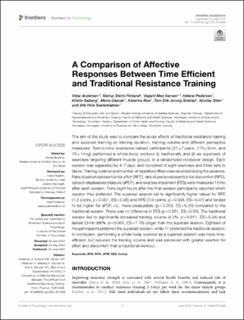| dc.contributor.author | Andersen, Vidar | |
| dc.contributor.author | Fimland, Marius Steiro | |
| dc.contributor.author | Iversen, Vegard Moe | |
| dc.contributor.author | Pedersen, Helene | |
| dc.contributor.author | Balberg, Kristin | |
| dc.contributor.author | Gåsvær, Maria | |
| dc.contributor.author | Rise, Katarina | |
| dc.contributor.author | Solstad, Tom Erik Jorung | |
| dc.contributor.author | Stien, Nicolay | |
| dc.contributor.author | Sæterbakken, Atle Hole | |
| dc.date.accessioned | 2022-09-01T08:28:21Z | |
| dc.date.available | 2022-09-01T08:28:21Z | |
| dc.date.created | 2022-06-16T14:17:05Z | |
| dc.date.issued | 2022 | |
| dc.identifier.citation | Andersen, V., Fimland, M. S., Iversen, V. M., Pedersen, H., Balberg, K., Gåsvær, M., Rise, K., Solstad, T. E. J., Stien, N., & Saeterbakken, A. H. (2022). A comparison of affective responses between time efficient and traditional resistance training. Frontiers in Psychology, 13. | en_US |
| dc.identifier.issn | 1664-1078 | |
| dc.identifier.uri | https://hdl.handle.net/11250/3015026 | |
| dc.description.abstract | The aim of the study was to compare the acute effects of traditional resistance training and superset training on training duration, training volume and different perceptive measures. Twenty-nine resistance-trained participants (27 ± 7 years, 173 ± 9 cm, and 70 ± 14 kg) performed a whole-body workout (i) traditionally and (ii) as supersets of exercises targeting different muscle groups, in a randomized-crossover design. Each session was separated by 4–7 days, and consisted of eight exercises and three sets to failure. Training duration and number of repetitions lifted were recorded during the sessions. Rate of perceived exertion for effort (RPE), rate of perceived exertion for discomfort (RPD), session displeasure/pleasure (sPDF), and exercise enjoyment (EES) were measured 15 min after each session. Forty-eight hours after the final session participants reported which session they preferred. The superset session led to significantly higher values for RPE (1.3 points, p < 0.001, ES = 0.96) and RPD (1.0 points, p = 0.008, ES = 0.47) and tended to be higher for sPDF, i.e., more pleasurable, (p = 0.059, ES = 0.25) compared to the traditional session. There was no difference in EES (p = 0.661, ES = 0.05). The traditional session led to significantly increased training volume (4.2%, p = 0.011, ES = 0.34) and lasted 23 min (66%, p < 0.001, ES = 7.78) longer than the superset session. Eighteen of the participants preferred the superset session, while 11 preferred the traditional session. In conclusion, performing a whole-body workout as a superset session was more time-efficient, but reduced the training volume and was perceived with greater exertion for effort and discomfort than a traditional workout. | en_US |
| dc.language.iso | eng | en_US |
| dc.publisher | Frontiers Media S.A. | en_US |
| dc.rights | Navngivelse 4.0 Internasjonal | * |
| dc.rights.uri | http://creativecommons.org/licenses/by/4.0/deed.no | * |
| dc.title | A Comparison of Affective Responses Between Time Efficient and Traditional Resistance Training | en_US |
| dc.type | Peer reviewed | en_US |
| dc.type | Journal article | en_US |
| dc.description.version | publishedVersion | en_US |
| dc.rights.holder | © 2022 Andersen, Fimland, Iversen, Pedersen, Balberg, Gåsvær, Rise, Solstad, Stien and Saeterbakken | en_US |
| dc.subject.nsi | VDP::Medisinske Fag: 700::Idrettsmedisinske fag: 850::Treningslære: 851 | en_US |
| dc.source.volume | 13 | en_US |
| dc.source.journal | Frontiers in Psychology | en_US |
| dc.identifier.doi | 10.3389/fpsyg.2022.912368 | |
| dc.identifier.cristin | 2032517 | |
| cristin.ispublished | true | |
| cristin.fulltext | original | |
| cristin.qualitycode | 1 | |

